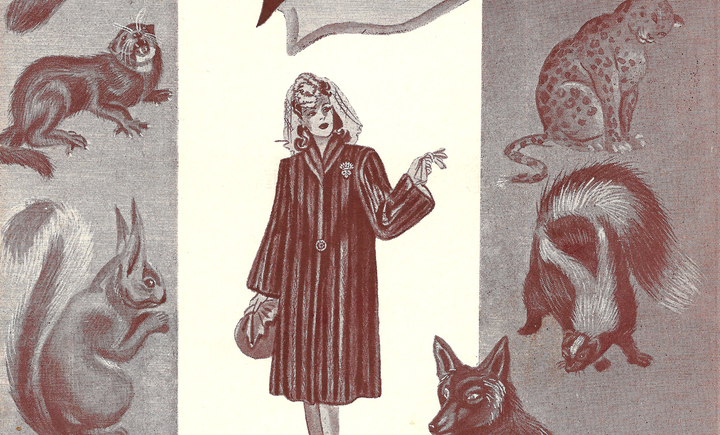
Detail from “Fur Fashions: Fall & Spring 1942 1943“
Why are people so drawn to fur coats and fur trim? "Fur stands for the pubic hair", wrote Freud. Since fur is a sensual object: soft, exotic, transformative, ripe with animal-otherness - it’s a highly sexualized symbol. According to art historian Joanna M. Gohmann, Ph.D, fur allows humans to safely explore behaviors often characterized as ‘animalistic’ at the expense of the non-human animal - especially their sexual animality. In sex, human animality is laid bare.
But it isn’t just sex. The other reason people buy fur is because it’s a symbol of power. Power over animals and nature is an obvious starting point, but there is also a long history of fur, and specific types of fur, being used - and legally enforced through sumptuary laws - to distinguish between those in power (royalty, nobility and the wealthy) and those down the ladder - with potentially deadly consequences for those who broke the fashion laws. In many cases, dressing up in furs is a way of visually appearing to be on a higher rung of that ladder, even if the fur is ugly. This is a rare place in fashion where a symbol of power supersedes its need to be beautiful or even functional. An ugly or dowdy fur coat is still a desired object because in Western culture, the only thing more valued than beauty is power. To many people who are drawn to use the fur symbol, simply throwing a tattered, second-hand fur on top of any outfit feels transformative if not transcendent, and they might not even know why.
But let’s get back to sex for a second, because while the political and economic power that fur represents can be invoked by nearly anyone, patriarchal power is the place at which the sex and power of fur tend to intersect.
Dressing in fur, especially for femme-presenting people, can be interpreted as dressing as exotic prey, a trophy or a conquest, and thereby transforming into those who are pursued and overpowered by men. Wearing the skins of animals like wildcats makes the perceived difficulty (and payoff) of overpowering a dangerous predator even greater. In nature most animals will not allow humans to touch them. Touching occurs only when they are captured or killed, so the femme-presenting wearer of fur may represent the dangerous or docile sought and hunted, the desired, and ultimately the captured, killed, touched and consumed. As Brian Luke discusses in his book Brutal: Manhood and the Exploitation of Animals, many hunting writers describe hunting as a masculine, sexually-charged experience: using mating calls, mating scents, pursuing, waiting, and ultimately penetrating their victims with phallic arrows or guns and bullets, killing them, touching their previously forbidden bodies, and sometimes consuming them. They express loving the animals they capture or kill in no uncertain terms.
In 1870, Leopold von Sacher-Masoch’s novel Venus in Furs established the motif of the fur-wearing woman as dominatrix, a sexually powerful and transgressive being, a predator with weapons who is not necessarily overpowered by man, but still maintains the exotic otherness of her animality as symbolized in fur and leather.
Today, for most people, fur is not a necessity. High-tech synthetics outperform fur. But to some, the fur garment is an irresistible status-symbol, representing all or any of the things in the spectrum of power and sex - under the guise of utility, of course. Strangely, fur has also come to represent rebelliousness and transgression. In the wake of the anti-fur movement that reached global proportions in the 1990s and early 2000s, the power of fur is actually reinforced, which may seem counterintuitive considering the increased and ongoing release of exposés and investigations that document how horrific life and death is for animals caught in traps or languishing on fur farms. Yet the issue is progressively polarized, and for many people who take pride in wearing fur, they perceive those who are anti-fur as misled do-gooders at best (and terrorists at worst) and reject the supposed wholesomeness of compassion for animals in favor of an ostensibly rebellious symbol of ruthless power.
How does this happen? It’s simple. In the same way that an ugly fur coat proves that power supersedes aesthetic beauty, a desire to appear powerful also supersedes virtuousness. In his book A Philosophy of Evil, contemporary philosopher Lars Svendsen argues that, “it's always easier to do evil than to do good; easier to hurt another human being in ways that will haunt them for the rest of their lives than to provide a comparable amount of help”. Wickedness is easy access to power. Virtuousness is a difficult path to power. Therefore, the willingness to harm (or at least the appearance of a willingness to harm) is rewarded with symbolic power.
The more cruel a production process, the higher the payoff is perceived to be. We see this in cuisine with things like foie gras, ortolan and veal, and we see it in fashion with things like skins and furs.